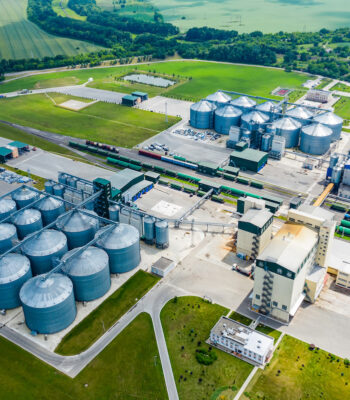Decarbonization doesn’t happen organically—it requires a plan. In this article, we share a framework for how to reduce scope 1 emissions thoughtfully and intentionally, with the additional benefits of optimizing operating expenses and overall efficiency. This is the approach we use with our clients, and we’ve tested it across sectors, regions, and industries.
Understanding how to reduce scope 1 emissions: A step-by-step framework
Step 1: Map your company’s scope 1 emissions sources
Scope 1 emissions come from the combustion of fuels and vary significantly by sector and region. There are many viable ways to reduce an organization’s scope 1 emissions already on the market, but they’re not one size fits all.
Prior to implementing any emission reduction project or solution, it’s important to be able to answer two questions:
Question 1: What are the main sources of your Scope 1 emissions?
To illustrate how Scope 1 emissions sources vary by industry, we often present them as a continuum between Industrial and Commercial businesses. On the far left, heavy-emitting industries like oil refineries or cement plants have significant Scope 1 emissions, but their largest sources are highly specific to their processes. On the far right, commercial sectors like Retail or Professional Services tend to have a small portion of their operational emissions coming from Scope 1 – we typically recommend that they focus their energy (pun intended) on Scope 2 actions.
The middle of this continuum are many industrial operations, like manufacturing, processing, refrigeration, and logistics. Meaningful Scope 1 emissions for these processes often fall into three categories: stationary combustion (most notably from heat production for the manufacturing process), fuel consumption by mobile equipment, and fugitive emissions, or leaks of greenhouse gasses from chemical venting, refrigeration, or air conditioning units.
Leaks often go undetected and thus may seem like a small problem, but the gasses that are emitted through fugitive emissions are often highly potent and destructive to the environment – with global warming potential (GWP) greater than 1000 times that of CO2. To quantify these emissions, seek out records of refrigerants purchased and input to top-up refrigeration or air conditioning equipment, or connect with environmental or processing engineers – they often track fugitive emissions from industrial processes for reporting to environmental protection agencies.
Question 2: Where are scope 1 emissions concentrated?
At Optera, we typically advise clients to prioritize emission reductions action for facilities where more than 15% of Scope 1 and 2 emissions come from Scope 1. You’ll eventually want to tackle all facilities, but facilities with this concentration of Scope 1 have a more significant reduction potential.
You should have the data to answer these two questions from your latest emissions inventory, but it helps to have a software solution to help you dive deeper into trends and segment emissions by meter and facility or location. Prioritization is key to making sure you’re focusing your efforts in the most impactful places.
Step 2: Maintain, upgrade, and replace to maximize efficiency
Once you’ve prioritized your facilities and understood where your emissions are coming from, it’s time to focus on how to reduce scope 1 emissions through efficiency improvements. Work with your facilities team to make sure that the equipment in the facility, and the facility itself, is undergoing standard maintenance to maintain or add thermal insulation, stop leaks of steam and hot water, and improve combustion processes. Simply improving operating philosophy, installing better controls, and undertaking preventative maintenance can improve industrial combustion processes and equipment by 3-10% [example 1, example 2].
When it’s time to replace old equipment, prioritize updated models that offer greater efficiency and lower emissions. You may want to pay special attention to equipment that uses refrigerants, looking for replacements that use low-GWP alternatives to hydrofluorocarbons (HFCs) – making a significant difference in energy efficiency and associated emissions (and aligning to the 2016 Kigali Amendment to phase out HFCs)
For transportation emissions, also look for upgrades to improve aerodynamics, like fairings and spoilers; reduce friction, like low rolling resistance tires; and optimize efficiency in driving techniques, routes and load packing. These types of logistical improvements can reduce emissions by 15-20% – well worth the effort as you plan for future investments in electric transport.
Step 3: Look for fuel-switching opportunities
When considering how to reduce scope 1 emissions permanently, one of the best moves is to switch to more sustainable sources of energy – this is where electrification comes into play. If you have the infrastructure to support it, consider investigating emerging technologies like industrial heat pumps, direct electrical heating or low-/no-heat process technologies – these can make a massive impact (especially if you can move to renewable energy at the same time). Take advantage of moments when you already need to replace equipment – or when your facilities are already shut down for maintenance – to optimize your return on investment.
That said, not all organizations will have the infrastructure to support electrification – particularly in countries where the electrical grid is not as mature. If you have the ability to switch from one form of fuel to a less emission-intensive option, that can be a positive step – for example, switching from coal to natural gas or diesel to biodiesel. And look for ways to integrate zero-emissions heat sources, like solar thermal for hot water or drying processes or even developing new facilities in locations with access to geothermal energy.
Step 4: Plan for process redesigns
As you continue to explore how to reduce scope 1 emissions, you may need to consider more fundamental changes to your processes. This can happen due to climate damaged infrastructure, energy price swings, the need for a pathway to achieve net-zero or a snowballing of multiple issues.
This is a long-term play, and requires thoughtful sequencing. It’s going to require buy-in from your organization’s energy engineers, process engineers, and/or building engineers – not to mention leadership, as these kinds of changes can be costly, are core to a company’s operations, and require top-down support. Carbon accounting can help you illustrate how much your company’s existing processes and infrastructure contribute to your emissions problem. And in many cases, new and innovative technologies like direct electrical heating can result in better process control, higher quality, and higher consistency – benefits most process engineers will find compelling.
We often suggest that clients begin with illustrating their ideal end-state for their processes, and then “backcast” to determine how to develop each facility to achieve that end state. For example, we worked with a semiconductor manufacturer that, during a blank-sheet process design effort, identified radical improvements they could make in energy efficiency for a new facility’s vacuum pumps. In undergoing this process, they realized they could retrofit that same update at their existing facilities and newly acquired facilities – resulting in cost savings across the company that became part of the purchasing strategy.
And a note – if you’re going to put effort into redesigning your processes from the ground up, we’d recommend skipping other fuel-switching options and moving straight to electrification wherever possible. It’s the most effective way to reduce Scope 1 emissions and will become standard as the technology evolves and grows.
Finally: Stay positive and focused
Addressing Scope 1 emissions can be daunting, but it’s worth it – beyond the emissions savings, it can also result in OPEX savings and operational efficiency. To make it manageable, focus on specific facilities to prioritize action, and keep a long-term eye on the direction you want your organization to move. Collaborate with other organizations in your industry to share best practices – they’re often attempting to solve the same problems you are, and by not going it alone, you may discover there are more proven solutions already out there than you may have realized. And if you run into barriers, don’t get discouraged – there are many paths and solutions you can try, and more on the way.
And as you navigate your own reduction plan, the Optera team is here to help. Get in touch with us for more tailored support in understanding your options.
Other articles in this series:
5 Steps to reduce your scope 2 emissions
4 Steps to address your scope 3 emissions


